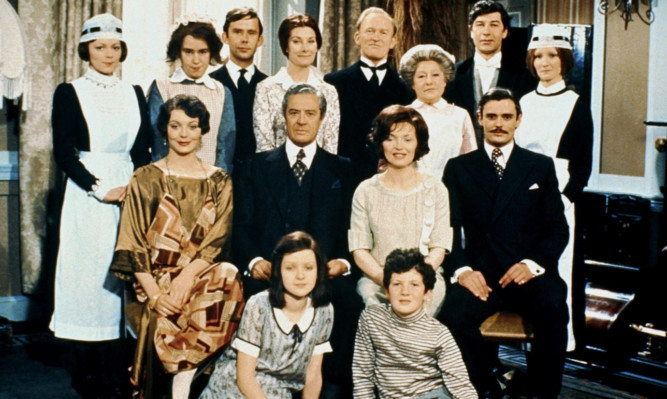
IT was the TV show that captivated Britain and beyond and even the biggest shows today pinch more than a bit from Upstairs, Downstairs!
Richard Marson spent many hundreds of hours thoroughly engrossed in the classic TV series, which ran from 1971 to 1975 over 68 episodes, and went on to work behind the scenes on Blue Peter, Doctor Who and other iconic shows.
He even wrote a book about Updown, as it’s known, and nobody knows better the tale of posh folk upstairs and servants literally below them.
“What shows from today borrow from Upstairs, Downstairs?” asks Richard. “That’s easy, Downton Abbey for one, and it takes plenty of ideas from it!
“It feeds off the corpse of Upstairs, Downstairs! It’s set in a country house, whereas Updown was in a London townhouse, and Downton is about the aristocracy while Updown was more the aristocracy marrying slightly beneath them.
“So they would say potay-to, I would say potah-to, but what they are really doing is following the same era and exploring the British obsession with class, through the contrasting lives of the servants downstairs and the other people upstairs.
“Downton is what I’d call Teatowel Telly, as it doesn’t go very far beneath the surface,
“Upstairs, Downstairs, however, comes from an era when TV drama was more theatrical.
“OK, the production values might mean it looks a bit like Crossroads in period frocks, but where it scores is with the scripts.
“They do have something to say and are very compelling, while Downton is more Crossroads in the script.”
Richard admits Downton does look beautiful, while Upstairs, Downstairs was full of dark interiors and sets that didn’t look very strong.
However, as a lad, he watched every episode avidly, then later repeats, when he convinced someone with a video recorder to tape it all.
He even tracked down some lost black-and-white episodes, and for his book made contact with many who had worked on the show, including one actor whom he was told had died!
He isn’t surprised Upstairs, Downstairs has done so well in foreign climes, too.
“The whole thing about British class fascinates the Americans, Japanese, people on the Continent, and they are also interested in our Royal Family, houses, the lifestyle, and the ridiculous behaviour that doesn’t have a place in this century!” he adds.
It would potentially have been even more of a hit had Honor Blackman and George Cole starred in it, as was originally hoped.
It’s intriguing to imagine how the Avengers bombshell, and the future Arthur Daley of Minder fame, would have fitted in as Lady Marjorie and Hudson.
“Honor Blackman would certainly have been a more, sexy Lady Marjorie!” Richard laughs.
“George Cole would have been a great piece of casting, I think that would have worked really well.
“As with any casting, they thought about all sorts of people, but the genius casting was Gordon Jackson as Mr Hudson.
“He had a great British film career, but I don’t think he was doing well at the time of casting.
“Even 45 years later, you can’t underestimate how popular some of the cast were, and Mr Hudson and Mrs Bridges were huge cult figures and very effective.
“You picture Gordon Jackson as he was the only one who spanned both upstairs and downstairs.
“We have a fascination with the job of butler, as they are like some kind of top-level civil servants, who see everything and are supposed to be discreet.
“But they have a huge impact on everyone, upstairs and down, and he did it brilliantly.
“It could have been a one-level character, a bit dull, but Gordon Jackson did a lot with it.”
Incredible as it sounds it went on to be an instant massive hit and remains much-loved to this day the TV bosses didn’t fancy Upstairs, Downstairs.
“It’s extraordinary that it even got off the blocks,” Richard reveals.
“In the early 70s, there were a number of shows not doing well, and London Weekend (who made it) weren’t doing well.
“Nobody was waving a flag for this show, it was mainly commissioned as it was cheap,
Only six episodes were originally agreed to be shown, and it could have been buried altogether.”
The whole future classic, in fact, was left in storage for a year!
“The minute they caved in, the whole country tuned in and loved it,” reveals Richard.
“Even late on a Sunday night, it just took off.”
“Of course, it was in the papers as time went on, with Pauline Collins and John Alderton in the press, but there was nothing like the degree of attention TV series get today.
“I remember Lesley-Anne Down being told: ‘You won’t be able to walk down the street without people looking at you and talking about Upstairs, Downstairs,’” and she thought that was nonsense.
“But there were only a few channels back then, and that was how it turned out!”
The British telly classic that almost never saw the light of day.

Enjoy the convenience of having The Sunday Post delivered as a digital ePaper straight to your smartphone, tablet or computer.
Subscribe for only £5.49 a month and enjoy all the benefits of the printed paper as a digital replica.
Subscribe